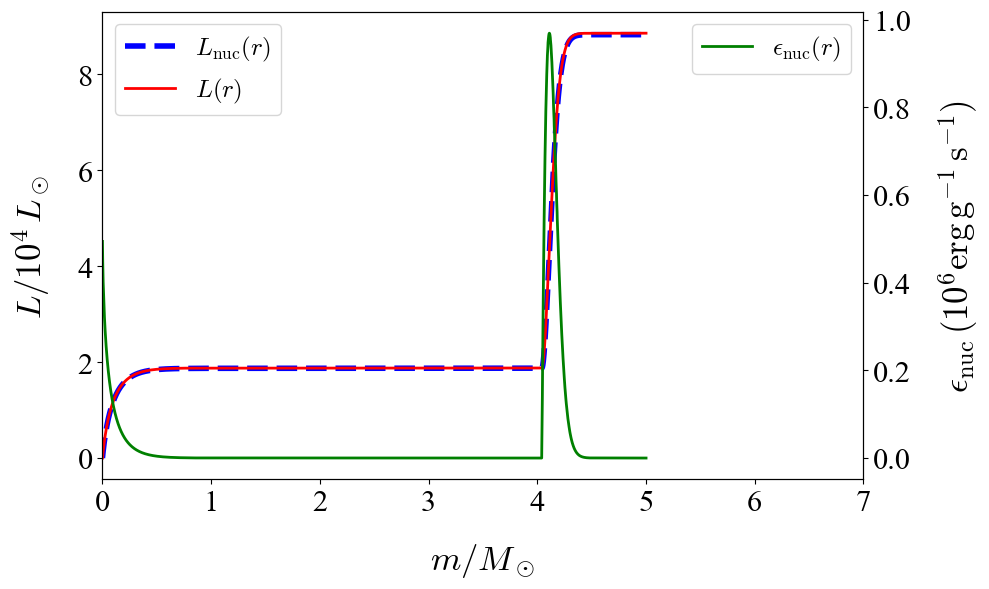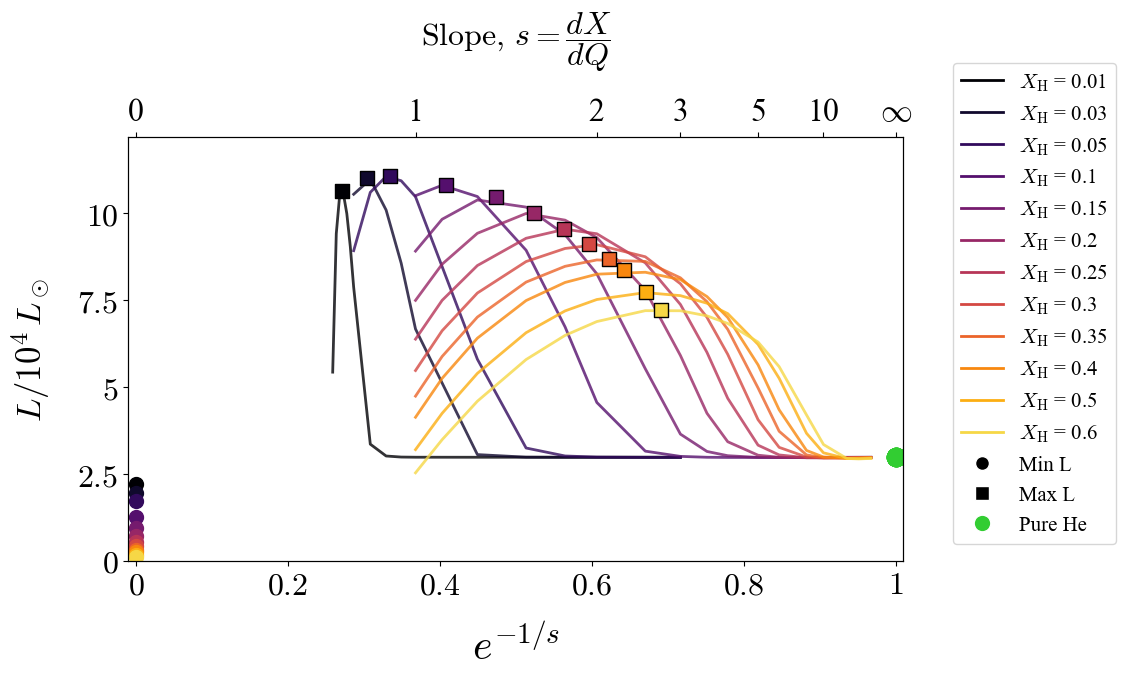Welcome to the Mass-Luminosity Relation (MLR) Calculator page. This web interface enables users to compute minimum, maximum, and pure-helium mass-luminosity relations (MLR), based on the stellar structure models presented in Sabhahit et al. (2025b). This work builds upon existing MLRs in the literature by incorporating structure models featuring a helium (He) core and hydrogen (H) shell - configurations that can result from partial envelope stripping and appear to break simple homology relations.
MLRs in the literature
Typically, based on homology relations \(L \sim \mu^4 M^3\), the minimum luminosity for a given total mass \(M_\mathrm{tot}\) and surface hydrogen mass fraction \(X_\mathrm{H}\) occurs for a fully chemically homogeneous star with \(X(m) = X_\mathrm{H}\). The maximum luminosity occurs for a pure-He model configuration with \(X(m) = 0\), which, from an evolutionary perspective, corresponds to full envelope stripping. Conversely, the maximum mass for a given luminosity and surface \(X_\mathrm{H}\) occurs for a chemically homogeneous star while the minimum mass occurs for a pure-He model. Such maximum and minimum MLRs are provided in Gräfener et al. (2011).
How do we build upon this?
In Sabhahit et al. (2025b), we construct a large grid of stellar structure models in hydrostatic and thermal equilibrium consisting of a pure-He core with an overlying hydrogen shell. The grid is generated by varying four primary parameters: the total mass \(M_\mathrm{tot}\), the surface hydrogen mass fraction \(X_\mathrm{H}\), the metal mass fraction \(Z\), and the H profile slope \(s\) (the definition of slope follows Schootemeijer & Langer 2018) that governs how \(X_\mathrm{H}\) depletes from the surface value to zero at the edge of the pure-He core. The two limiting cases, \(s = 0\) and \(s = \infty\), correspond to the previously known MLRs for fully chemically homogeneous and pure-He configurations, respectively. However, a broad set of new structure models emerges between these two extremes, where the star possesses a relatively massive He-burning core and a low-mass H-burning shell. From an evolutionary perspective, such a structure can result from partial stripping of the envelope via strong single-star wind mass loss or through stable mass transfer beyond the main sequence via Roche lobe overflow.
The inclusion of such He-core + low-mass H-shell structures leads to very interesting MLRs because the H shell can contribute disproportionately to the total luminosity budget. What do we mean by that? See Figure 1, where we show the internal luminosity stratification of a \( 5 \, M_\odot \) model consisting of a \( 4 \, M_\odot \) core and a \( 1 \, M_\odot \) hydrogen envelope. The surface \(X_\mathrm{H}\) is 0.3 and the H profile slope is \(s = 2\). The two spikes in the nuclear energy generation rate mark the two burning regions. The H shell, despite occupying only one-fifth of the total mass, contributes about three-fourths to the total luminosity. This example structure model outputs a total luminosity greater than that of a pure-He model of the same mass, thereby breaking the homology relations.

Figure 1: Luminosity stratification of a \( 5 \, M_\odot \) model with a \( 4 \, M_\odot \) He core and \( 1 \, M_\odot \) H shell. The two spikes in the specific nuclear energy generation rate at \(0\) and \( 4 \, M_\odot \) marks the He burning core and the H burning shell.

Figure 2: Variation of luminosity as a function of slope \( (0 \leq s \leq \infty) \) for different values of surface \( X_\mathrm{H} \). The total mass \( M_{\text{tot}} \) is fixed at \( 5\, M_{\odot} \). The figure shows the luminosity peak at an \( s \)-value between the extremes \( s = 0 \) and \( s = \infty \).
In Figure 2, we plot the variation of surface luminosity with slope \( s \) for different values of surface \( X_\mathrm{H} \), while fixing \( M_\mathrm{tot} \) to \( 5 \, M_\odot \). We observe that for a given \( M_\mathrm{tot} \) and \( X_\mathrm{H} \), the minimum luminosity still corresponds to the \( s = 0 \) chemically homogeneous model. However, the maximum luminosity does not occur for the \( s = \infty \) pure-He model, but rather at an intermediate slope with a He-core + H-shell structure corresponding to partial stripping. Similarly, the minimum mass does not correspond to the pure-He model either, but again to a He-core + H-shell configuration.
This webpage provides an interactive calculator to predict the minimum, maximum, and pure-He masses and luminosities, including models with such He-core + H-shell structures. Please read the how to use and disclaimers before using the tool. Thank you for reading - enjoy!